70.8 North, 69.2 East. It’s the Lat, Long coordinate location of a section of the Yamal Peninsula in Siberian Russia. A typically chilly region of frozen but now thawing ground more than 4 degrees of Latitude north of the Arctic Circle. A place that saw the appearance of odd, disturbing (and now controversial) methane blowholes pockmarking the melting permafrost during 2014. Today, the high temperature in a land now being forced to rapidly warm by human-caused climate change spiked to a tropical 80 degrees Fahrenheit (26.4 C) at 0800 UTC. Tomorrow, temperatures are expected to again rise to 80 F (26.5 C). And in the same location on Thursday, the mercury is forecast to strike close to 86 F (30 C).
Across the Arctic Ocean at Latitude 71.4 North and Longitude 111.7 West, Canada’s Victoria Island is today also seeing temperatures spike to near 80 F (26.8 C). It’s a place encircled by sounds of wet crackling and fluid sighs. The mournful songs of melting sea ice. A sad threnody for the end of a much more stable and hospitable climate age. And there, and even further north to Banks Island, readings are expected to range from 80 to 82 F (26.7 to 27.7 C) on Wednesday and into Thursday.
(Extreme heat wave predicted to build over the Arctic during the next five days as indicated by daily maximum temperatures forecast for the next five days shown above. Image source: Climate Reanalyzer.)
The heatwave in Northern Siberia comes on the back of new record high temperatures of 93 F (33.8 C) being reached in Buryatia on July 1 amidst record thunderstorm-induced downpours. The heat has since built northward along an extended ridge stretching over Central Asia and has now compromised a large section of the Arctic Circle zone.
On the Canadian side, the odd warmth comes in the form of a weird Northern heat island. The heat near the Canadian Archipelago is surrounded by cooler regions north, south, east and west. The result of a heat dome high pressure ridge building in over this far Northern region during the coming week.
Weather monitors like the Global Forecast System model show that both of these regions are in for some very severe Arctic heat over the next five days. High temperatures in the range of 80 to 86 F (26 to 30 C) are about 27 to 36 degrees Fahrenheit above average (15 to 20 C). Temperatures that will basically match those in Central America (8.3 N, 77.9 W) during the same time period. In other words, for these days and these regions, Arctic temperatures will roughly match tropical Equatorial temperatures.
Conditions in Context — 408 ppm CO2, 490 ppm CO2e is Forcing the Arctic to Warm Faster Than Lower Latitudes
This most recent Arctic heatwave occurs in a climate context that, taking into account for 408 ppm CO2 alone will likely result in 1-2 C of additional global warming (on top of current approximate 1 C warming since 1880s) over the long term. Meanwhile, total CO2e (including methane and other greenhouse gasses) measures of about 490 ppm imply 1.5 to 3 C of additional warming long term (on top of 1 C current) even if the present total greenhouse gas forcing is only maintained (not added to by human beings or the Earth System).
These are global averages. But all that extra heat forcing is causing the world to warm unevenly. As of 2009, the Arctic was warming up at a pace more than two times faster than the rest of the globe. And in the 40 year period from 1971 through 2011 NASA found that the Arctic had warmed about 3.55 degrees Fahrenheit while the rest of the world had warmed by 1.44 F. But that was before the big global heat spike during 2015 and 2016 further disproportionately heated the Arctic — pushing it into new record hot temperature ranges. In the end, it appears that the Arctic will eventually warm by about 2.5 to 3 C for every 1 C of overall global temperature rise. And the extreme heat we are seeing now in the Arctic is just a larger part of the geologically rapid warming trend now being driven primarily by human fossil fuel emissions.
(NASA graphic shows Arctic warming at a faster rate than the rest of the world. The capture is for 2000 through 2009 vs the NASA 1951 through 1980 20th Century baseline. Read article here at NASA’s Earth Observatory.)
Impacts like loss of sea ice’s cooling albedo effect (reflectivity), loss of land albedo due to greening and loss of snow cover, and unlocking of local carbon stores due to rising heat, expanding fires, and changes in weather all contribute to this more rapid rate of Northern Hemisphere Polar warming. In addition, warming oceans, northward moving climate zones, and warm wind influx events generated by weaknesses in the Polar Jet Stream preferentially transport heat toward the Arctic (especially during Winter). These various forcings generate an overall greater degree of warming for the Arctic Ocean region during Winter all while Summer sees extraordinary heat racing to the Continental edges North of the Arctic Circle.
The only effective way to slake this warming is to both halt human greenhouse gas emissions — which are the major driver of the big heat build up the world is now experiencing — as rapidly as possible while pursuing ways to remove the excess carbon loading from the Earth Atmosphere. Without these necessary responses and mitigations, more warming will continue to be locked into the pipeline and the greater the eventual temperature departure from 1880s (Holocene) values will ultimately become — with the Arctic increasingly entering a hot zone.
Links/Statements/Attribution:
What’s Causing the Poles to Warm Faster Than the Rest of The Earth?
Paleoclimate Tells Us We Have 1-2 C Additional Warming in Pipeline From CO2 Forcing
Record Heat and Abnormal Flooding as Siberia Gets Freak Weather
Scientific hat tip to Dr. Jennifer Francis
Hat tip to Cate
Hat tip to Spike
Hat tip to Colorado Bob
(Note: This post is not intended to draw any specific conclusion on the scientifically controversial issue of potential Arctic carbon store releases. Time-frames and thresholds for such potential amplifying feedbacks in response to human-forced warming — be they small, moderate, large or catastrophic — are currently not very well understood in the science. Mainstream science asserts that such feedbacks will tend to be more moderate and happen over longer time scales given current understanding of carbon store resiliency. That said, the amount of heat build up due to human-forced warming in the Arctic is impressive and concerning. For these reasons carbon store sensitivity necessitates close monitoring and further research by responsible observers.)































